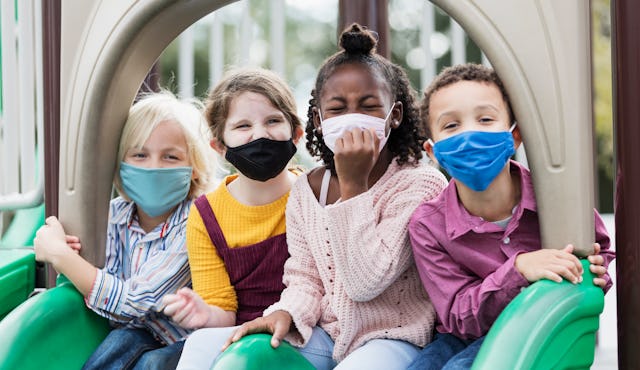How to Help Your Kids’ Mask-Induced Dry Skin How to Help Your Kids’ Mask-Induced Dry Skin

As much as I am grateful for KN95 masks sized specifically for tiny faces, after a long day of school and activities — especially in the dead of winter — the ear holders in particular can really wreak havoc on their skin. While not wearing masks (even after they’re vaccinated) isn’t a good option, fortunately there are some solutions that can ease pressure on little ears and help heal their irritated skin. Read on for some tips and tricks to keep your children’s skin as healthy as possible while staying COVID-safe.
Why do face masks worsen skin conditions like acne and eczema?
While wearing face masks is the new normal (and vital to helping curb the spread of COVID), it can be uncomfortable and irritate skin — especially the tender faces and behind-the-ear skin of young children. Often, face masks are too tight or made of scratchy, chafing materials that can rub against your child’s face, causing itchiness or worsening conditions like eczema around the chin, cheeks, and lips.
Plus, some masks can dry out skin by absorbing all the natural moisture, and your child’s trapped breath and airflow can also cause dryness, redness, and itchiness.
Common face mask skin problems
Different kids and different age groups will have different skin care issues. Here are a few of the more common ones your child may experience.
Dry skin, eczema, rosacea, or contact dermatitis: Whether it’s just dry winter air or the mask drying out your child’s skin, dry skin can cause flakiness, bumps, rash, dryness, peeling, and even swelling and numbness. The conditions within a mask can also worsen the symptoms of eczema, rosacea, and other skin conditions.
“Maskne”: This is the nickname for facial acne worsened by mask wearing due to your child’s sweat, bacteria, and skin oils being trapped on their skin.
Irritation of skin behind ears: The skin behind your child’s ears is delicate and after wearing masks all day, the skin can get abraded and worn down — sometimes leading to open sores or torn skin. Plus, the pressure can hurt, too.
Tips to protect your child’s skin from face masks
While we can’t stop wearing masks, there are proactive measures you can take to protect your children’s sensitive skin.
Wash and moisturize their face daily: Use a mild, fragrance-free cleanser. After, while their face is still damp, apply moisturizer that is best for their skin type. If their skin is on the dryer side, consider applying moisturizer right before they put on their mask for the day.
Use petroleum jelly or chapstick: To prevent cracked lips, apply a thin layer of petroleum jelly or chapstick on their lips after face washing, before putting on their mask, and also right before bedtime.
Ear-saving clips and headbands: There are all sorts of clips, headbands, and hats that your child can wear with special buttons they can loop the elastic of their masks around to relieve the pressure and abrasion of the delicate skin behind their ears.
Find the right fitting mask: Any mask is better than none at all, but a snug and comfortable fitting mask is best. If a mask is too loose or moves too much, not only will it irritate your child’s skin, but it also will increase the odds of your child touching their mask and transfer germs to their mask and face.